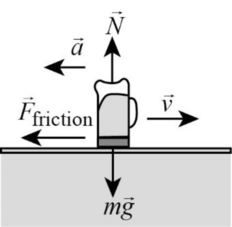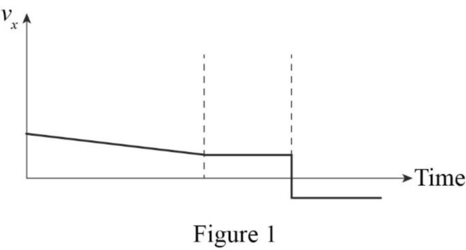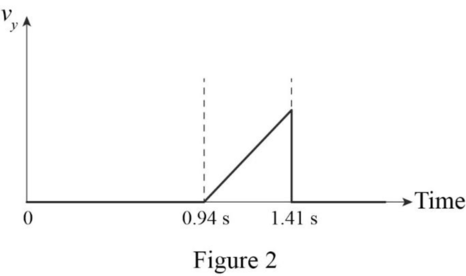
Concept explainers
(a)
The distance
(a)
Answer to Problem 72P
The distance
Explanation of Solution
Write the mathematical expression for Newton’s second law.
Here,
Write the
Here,
After the mug leaves the bar the projectile motion can be considered.
Consider the free body diagram.

Apply Newton’s second law to the free body diagram.
Write the expression for the
Substitute,
Write the expression for
Here,
Substitute equation (III) in(IV).
Here,
Write the kinematic equation for displacement in
Substitute,
Write the kinematic equation for displacement in
Conclusion:
Substitute,
Substitute,
Substitute,
Substitute,
Therefore, the distance
(b)
The velocity of the mug.
(b)
Answer to Problem 72P
The velocity of the mug is
Explanation of Solution
Write the expression for velocity along
Here the
Write the expression for the magnitude of the velocity.’
Write the expression for the direction of velocity.
Conclusion:
Substitute,
Substitute,
Substitute,
Therefore, the velocity of the mug is
(c)
The velocity time graph for both
(c)
Answer to Problem 72P
The velocity time graph for both
Explanation of Solution
Write the expression for the
Conclusion:
Substitute,
The velocity time graph for velocity in

The velocity time graph for velocity in

Therefore, the velocity of the mug is
Want to see more full solutions like this?
Chapter 4 Solutions
Bundle: College Physics: Reasoning And Relationships, 2nd + Webassign Printed Access Card For Giordano's College Physics, Volume 1, 2nd Edition, Multi-term
- dry 5. (a) When rebuilding her car's engine, a physics major must exert 300 N of force to insert a c piston into a steel cylinder. What is the normal force between the piston and cyli=030 What force would she have to exert if the steel parts were oiled? k F = 306N 2 =0.03 (arrow_forwardInclude free body diagramarrow_forwardInclude free body diagramarrow_forward
- Test 2 МК 02 5. (a) When rebuilding her car's engine, a physics major must exert 300 N of force to insert a dry = 0.03 (15 pts) piston into a steel cylinder. What is the normal force between the piston and cylinder? What force would she have to exert if the steel parts were oiled? Mk Giren F = 306N MK-0.3 UK = 0.03 NF = ?arrow_forward2. A powerful motorcycle can produce an acceleration of 3.50 m/s² while traveling at 90.0 km/h. At that speed the forces resisting motion, including friction and air resistance, total 400 N. (Air resistance is analogous to air friction. It always opposes the motion of an object.) What force does the motorcycle exert backward on the ground to produce its acceleration if the mass of the motorcycle with rider is 245 ke? a = 350 m/s 2arrow_forward2. A powerful motorcycle can produce an acceleration of 3.50 m/s² while traveling at 90.0 km/h. At that speed the forces resisting motion, including friction and air resistance, total 400 N. (Air resistance is analogous to air friction. It always opposes the motion of an object.) What force does the motorcycle exert backward on the ground to produce its acceleration if the mass of the motorcycle with rider is 245 kg? (10 pts) a = 3.50 m/s 2 distance 90 km/h = 3.50m/62 M = 245garrow_forward
- Using Table 17-4, determine the approximate temperature of metal that has formed a dark blue color.arrow_forwardA positively charged disk has a uniform charge per unit area σ. dq R P x The total electric field at P is given by the following. Ek [2 - x (R² + x2) 1/2 Sketch the electric field lines in a plane perpendicular to the plane of the disk passing through its center.arrow_forwardConsider a closed triangular box resting within a horizontal electric field of magnitude E = 8.02 104 N/C as shown in the figure below. A closed right triangular box with its vertical side on the left and downward slope on the right rests within a horizontal electric field vector E that points from left to right. The box has a height of 10.0 cm and a depth of 30.0 cm. The downward slope of the box makes an angle of 60 degrees with the vertical. (a) Calculate the electric flux through the vertical rectangular surface of the box. kN · m2/C(b) Calculate the electric flux through the slanted surface of the box. kN · m2/C(c) Calculate the electric flux through the entire surface of the box. kN · m2/Carrow_forward
- The figure below shows, at left, a solid disk of radius R = 0.600 m and mass 75.0 kg. Tu Mounted directly to it and coaxial with it is a pulley with a much smaller mass and a radius of r = 0.230 m. The disk and pulley assembly are on a frictionless axle. A belt is wrapped around the pulley and connected to an electric motor as shown on the right. The turning motor gives the disk and pulley a clockwise angular acceleration of 1.67 rad/s². The tension T in the upper (taut) segment of the belt is 145 N. (a) What is the tension (in N) in the lower (slack) segment of the belt? N (b) What If? You replace the belt with a different one (one slightly longer and looser, but still tight enough that it does not sag). You again turn on the motor so that the disk accelerates clockwise. The upper segment of the belt once again has a tension of 145 N, but now the tension in the lower belt is exactly zero. What is the magnitude of the angular acceleration (in rad/s²)? rad/s²arrow_forwardA bridge truss extends x = 217 m across a river (shown in the figure below) where 0 = 40°. The structure is free to slide horizontally to permit thermal expansion. The structural components are connected by pin joints, and the masses of the bars are small compared with the mass of a 1300 kg car at the center. Calculate the force of tension or compression in each structural component (in N). B D T T T T T 22820 AB AC BC ||| || || || BD N ---Select--- N ---Select--- N ---Select--- N ---Select--- DE N ---Select--- T DC= N ---Select--- TEC N ---Select--- с ✓ Earrow_forwardno ai pleasearrow_forward
 Principles of Physics: A Calculus-Based TextPhysicsISBN:9781133104261Author:Raymond A. Serway, John W. JewettPublisher:Cengage Learning
Principles of Physics: A Calculus-Based TextPhysicsISBN:9781133104261Author:Raymond A. Serway, John W. JewettPublisher:Cengage Learning Classical Dynamics of Particles and SystemsPhysicsISBN:9780534408961Author:Stephen T. Thornton, Jerry B. MarionPublisher:Cengage Learning
Classical Dynamics of Particles and SystemsPhysicsISBN:9780534408961Author:Stephen T. Thornton, Jerry B. MarionPublisher:Cengage Learning Physics for Scientists and Engineers: Foundations...PhysicsISBN:9781133939146Author:Katz, Debora M.Publisher:Cengage Learning
Physics for Scientists and Engineers: Foundations...PhysicsISBN:9781133939146Author:Katz, Debora M.Publisher:Cengage Learning Glencoe Physics: Principles and Problems, Student...PhysicsISBN:9780078807213Author:Paul W. ZitzewitzPublisher:Glencoe/McGraw-Hill
Glencoe Physics: Principles and Problems, Student...PhysicsISBN:9780078807213Author:Paul W. ZitzewitzPublisher:Glencoe/McGraw-Hill College PhysicsPhysicsISBN:9781285737027Author:Raymond A. Serway, Chris VuillePublisher:Cengage Learning
College PhysicsPhysicsISBN:9781285737027Author:Raymond A. Serway, Chris VuillePublisher:Cengage Learning Physics for Scientists and Engineers with Modern ...PhysicsISBN:9781337553292Author:Raymond A. Serway, John W. JewettPublisher:Cengage Learning
Physics for Scientists and Engineers with Modern ...PhysicsISBN:9781337553292Author:Raymond A. Serway, John W. JewettPublisher:Cengage Learning





